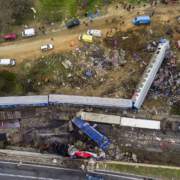Understanding Sleep Disorders and Fatigue Among Railroad Workers
In the quiet hours of one early morning, a freight train was barreling down the tracks in rural Alabama. The lone operator at the helm was a dedicated employee of many years. Suddenly, the train deviated from its planned course, derailing off a switch track. The subsequent investigation revealed a shocking yet increasingly common reality. The train operator, who was fortunately unharmed, had momentarily fallen asleep, the consequence of chronic fatigue and untreated obstructive sleep apnea.
Incidents like these underscore the pervasive issue of sleep disorders and fatigue among railroad workers, a significant problem that is widespread in the industry. Sleep disorders, especially obstructive sleep apnea, can severely disrupt an individual’s sleep patterns, resulting in insufficient sleep, and excessive daytime fatigue. This is particularly concerning for safety-critical railroad employees, like train operators and engine workers, whose job demands high levels of alertness and cognitive performance.
In the demanding work environment of the rail industry, fatigue levels can easily spike, especially among those working night shifts or in early morning hours. The problem is not confined to train and engine workers, individual employees such as maintenance of way workers, railroad signalmen, and train crew members also grapple with it. Irregular work schedules, long shifts, and the nature of their work often deprive these workers of a full night’s rest, thereby increasing their fatigue exposure.
The fatigue problem among railroad workers isn’t a mere inconvenience, but a significant risk factor leading to reduced alertness, slowed reaction times, and impaired judgment – factors that directly contribute to increased accident risk. Numerous train accidents have been linked to fatigue, emphasizing the urgent need to address fatigue and implement effective fatigue management strategies across railroad networks.
Sleep Disorders Among Railroad Workers
Sleep disorders refer to a range of conditions that significantly disrupt an individual’s sleep patterns, often leading to insufficient sleep, impaired functioning, and, over time, serious health complications. Among railroad workers, these conditions are unfortunately all too common and can have serious implications for their work performance, safety, and overall well-being.
As we touched on earlier, obstructive sleep apnea (OSA) is one of the most prevalent sleep disorders found among railroad workers. This condition is characterized by repeated episodes of upper airway obstruction during sleep, resulting in recurrent awakenings and disrupted sleep. This interruption of sleep patterns can lead to daytime sleepiness and chronic fatigue, making tasks requiring sustained attention, like operating trains or performing maintenance work, increasingly challenging and potentially dangerous.
In addition to obstructive sleep apnea, railroad workers may also experience other sleep disorders such as insomnia, shift work sleep disorder, and restless leg syndrome. These conditions can result from or be exacerbated by irregular work schedules, night shifts, or the stress and strain of safety-critical job roles within the rail industry.
According to the Federal Railroad Administration, a significant number of railroad employees, particularly safety-critical railroad employees such as train operators and engine workers, experience some form of sleep disorder. With prevalence rates that are estimated to be higher than the general population, these disorders represent a substantial health and safety concern within the railroad industry.
The risks associated with sleep disorders and sleep deprivation are considerable. Insufficient sleep can lead to impaired cognitive performance, decreased alertness, and increased reaction times – all crucial factors for railroad workers, especially those in safety-critical roles. The National Transportation Safety Board has identified fatigue, often stemming from untreated sleep disorders, as a contributing factor in a significant number of train accidents. This underscores the potential dangers that sleep disorders can pose not just to the affected individuals, but also to their colleagues, railroad operations, and the public.
Furthermore, certain sleep disorders, such as obstructive sleep apnea, are associated with other serious health conditions like cardiovascular disease and diabetes. Thus, the issue extends beyond immediate rail safety and concerns to include long-term health implications for railroad employees.
Fatigue Among Railroad Workers
Fatigue is defined as a state of chronic tiredness or exhaustion that goes beyond normal tiredness. It is an enduring feeling of weakness, decreased energy, or lack of motivation that can seriously impair an individual’s ability to perform tasks effectively and safely. Fatigue can result from insufficient sleep, prolonged mental or physical work, or extended periods of stress or anxiety. In the context of the railroad industry, it becomes a significant issue due to the nature of the job roles, the work environment, and the work schedules, particularly for those working during the night and in the early morning hours.
A significant number of railroad workers across various job types grapple with fatigue on a regular basis. For instance, train and engine workers often work irregular schedules that can disrupt their sleep patterns and lead to chronic fatigue. Similarly, railroad maintenance of way workers, who are responsible for keeping the tracks in good condition, often work long hours, sometimes in challenging weather conditions, which can significantly increase fatigue levels. Train crew members and railroad signalmen, too, are not exempt from this pervasive fatigue problem, given the demands of their safety-critical job roles.
The issue of fatigue is not merely about feeling tired; it’s about the detrimental effects it can have on an individual’s cognitive performance and the heightened risk it poses. Fatigue can slow reaction times, impair decision-making abilities, and hinder the ability to focus – all crucial requirements for jobs in the railroad industry, especially for those who operate trains or work on the tracks.
Given these factors, fatigue, particularly among railroad workers, has been identified as a significant contributor to increased accident risk within railroad operations. The National Transportation Safety Board has reported that human factor accidents, often related to fatigue, are a leading cause of railway accidents. In several instances, the final report of train accidents has pinpointed fatigue as a key contributing factor.
The Role of the Federal Railroad Administration and the National Transportation Safety Board
The Federal Railroad Administration (FRA) and the National Transportation Safety Board (NTSB) have been instrumental in addressing the issues of sleep disorders and fatigue among railroad workers. Both organizations recognize the serious implications of these problems for rail safety and have undertaken various initiatives to mitigate them.
The Federal Railroad Administration, as the governing body for rail industry safety standards, has been proactive in addressing sleep disorders and fatigue among railroad workers. One of their significant contributions is the development and implementation of fatigue management plans for rail employees. These plans are designed to help rail employees, particularly those in safety-critical roles, manage their fatigue levels effectively.
The FRA’s focus extends to the problem of sleep disorders like obstructive sleep apnea. They have advocated for regular sleep disorder screening for railroad employees, especially those in safety-critical roles such as train operators, engine workers, and train crew members. The FRA also encourages railroad companies to provide detailed information on the importance of sufficient sleep, the risks associated with sleep disorders, and the benefits of seeking treatment.
The National Transportation Safety Board, on the other hand, investigates accidents within the rail industry and provides valuable insights into the role fatigue and sleep disorders play in these incidents. The NTSB’s final reports on numerous train accidents have highlighted the role of fatigue, often stemming from untreated sleep disorders like obstructive sleep apnea.
In response to their findings, the NTSB has proposed a rule for mandatory fatigue risk management programs within the rail industry. This proposed rule emphasizes the need for fatigue prevention strategies, appropriate work scheduling, and the importance of sufficient rest periods for safety-critical railroad employees.
The Implications of Shift Work and Work Schedules
Shift work and irregular work schedules, which are common in the railroad industry, can significantly disrupt sleep patterns, contribute to sleep disorders, and exacerbate fatigue among railroad employees. This is particularly true for those who work night shifts or during the early morning hours when the body is naturally inclined towards sleep. This disruption of the body’s natural sleep-wake cycle, or circadian rhythm, can lead to chronic sleep deprivation and fatigue, and over time, can increase the risk of developing sleep disorders like obstructive sleep apnea.
The work environment and the type of job can also play a critical role in sleep disorders and fatigue among railroad workers. For example, safety-critical job roles, such as train operators, engine workers, and maintenance of way workers, often involve high levels of stress and responsibility, which can contribute to disrupted sleep and increased fatigue levels. Furthermore, work conditions such as high noise levels, variable lighting, and high vibration, particularly for train crew members and railroad signalmen, can interfere with both the quality and quantity of sleep obtained.
Recognizing these challenges, there is a growing emphasis on improving work scheduling as a part of fatigue management and fatigue prevention strategies. Adopting more regular work schedules, ensuring sufficient rest periods between shifts, and limiting night shifts can all contribute to better sleep patterns, reduced fatigue, and improved overall well-being among railroad employees. The Federal Railroad Administration supports these efforts, promoting changes in work scheduling as a critical aspect of fatigue management.
The Impact of Insufficient Sleep in the Railroad Industry
The importance of a full night’s rest cannot be overstated, especially in safety-critical job roles within the railroad industry. Insufficient sleep, defined as obtaining less sleep than the body needs for full rest and recovery, has profound effects on both physical and cognitive performance, and is a leading contributor to fatigue.
One of the most immediate consequences of insufficient sleep is decreased cognitive performance. Cognitive skills such as attention, memory, decision-making, and reaction time are all affected by lack of sleep. For railroad workers, these cognitive impairments can be particularly hazardous given their safety-critical job roles. For instance, train operators and train crew members need to stay alert and make quick decisions on the job. Insufficient sleep can compromise these abilities, leading to an increase in accident risk.
Insufficient sleep can also exacerbate existing sleep disorders like obstructive sleep apnea. Without a full night’s rest, the symptoms of these sleep disorders can become more severe, further impairing sleep quality and contributing to a vicious cycle of poor sleep and increasing fatigue.
In addition to its cognitive impacts, insufficient sleep also has physical consequences. Chronic lack of sleep can lead to various health problems over time, including cardiovascular disease, diabetes, and even certain types of cancer. This further underscores the importance of getting sufficient sleep, not just for job performance and safety, but for overall health.
The relationship between insufficient sleep and safety-critical job roles in the railroad industry is complex. Night shifts, early morning hours, and irregular work schedules can make it challenging for railroad employees to obtain sufficient sleep. However, given the significant implications of insufficient sleep for job performance and safety, addressing this issue is crucial to railway operations. This includes strategies like optimizing work schedules, implementing fatigue management programs, and promoting the importance of a full night’s rest among all railroad employees.
Current Efforts and Solutions
Given the significant issues that sleep disorders and fatigue pose to train drivers and to the rail industry, multiple efforts and solutions are currently being employed to address these concerns.
One of the primary initiatives within the rail industry involves fatigue management programs. Designed to help manage fatigue levels, these programs encompass a range of strategies such as implementing optimal work schedules, providing education on the importance of sufficient sleep and full night’s rest, and promoting healthy habits among railroad workers. Through these programs, the industry aims to reduce fatigue exposure and its associated risks.
Sleep disorder screening has also become a focal point of efforts to improve railroad worker health and safety. Regular screening for conditions like obstructive sleep apnea allows for early identification and treatment. By addressing sleep disorders proactively, the industry can significantly reduce one of the major contributors to fatigue among its employees.
In the realm of technology, the implementation of positive train control (PTC) systems has played a vital role in reducing fatigue-related risks. PTC systems automatically stop a train before certain types of accidents occur, including those that could result from operator error due to fatigue. With PTC systems, the rail industry has an additional layer of safety that can mitigate the risk of accidents, particularly those related to operator fatigue.
The use of self-assessments has also proven beneficial in managing fatigue and sleep disorders within the railroad industry. These assessments, which often include sleep and fatigue questionnaires, can identify individual differences in susceptibility to fatigue and sleep disorders. By understanding these individual factors, tailored interventions and supports can be implemented, leading to more effective management of fatigue and sleep disorders.
As the understanding of sleep disorders and fatigue continues to grow, so does the arsenal of strategies to address these issues within the railroad industry. Through a combination of organizational initiatives, technological advancements, and individual-focused strategies, the industry is making significant strides in improving worker health, safety, and overall job performance.
Steaming Ahead: Paving the Way for Safer Railways
The potential for significant reductions in risk that can be achieved by addressing sleep disorders and fatigue among railroad workers is monumental. These issues, often underestimated, can lead to substantial consequences on both the individual and collective level of train crews, compromising the safety and efficiency of the entire rail industry.
By proactively managing sleep disorders like obstructive sleep apnea and mitigating fatigue levels among railroad workers, we can significantly reduce the occurrence of fatigue-related train accidents and improve the overall well-being of the workforce. The use of fatigue management programs, regular sleep disorder screenings, and the implementation of technologies like positive train control all contribute to a safer work environment.
Furthermore, the recognition of individual differences, attention to work schedules, and understanding of the unique demands of job roles like those of train operators and engine workers, bring a nuanced approach to these issues. Additionally, personal strategies such as maintaining sufficient sleep, moderate caffeine use, and regular self-assessments, contribute to an overarching holistic approach to mitigating sleep disorders and fatigue.
Finally, it is essential to understand that the process of improving rail transport and road transport safety through better fatigue and sleep disorder management is an ongoing journey. As our knowledge and understanding of these issues grow, so too should our efforts to address them. The railroad industry, with its dedicated workforce and commitment to safety, has the potential to lead the way in this critical aspect of occupational health.












Leave a Reply
Want to join the discussion?Feel free to contribute!